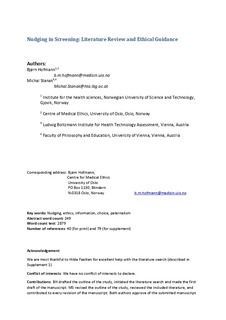| dc.contributor.author | Hofmann, Bjørn | |
| dc.contributor.author | Stanak, Michal | |
| dc.date.accessioned | 2019-04-30T09:07:51Z | |
| dc.date.available | 2019-04-30T09:07:51Z | |
| dc.date.created | 2018-06-20T11:17:07Z | |
| dc.date.issued | 2018 | |
| dc.identifier.citation | Patient Education and Counseling. 2018, 101 (9), 1561-1569. | nb_NO |
| dc.identifier.issn | 0738-3991 | |
| dc.identifier.uri | http://hdl.handle.net/11250/2596082 | |
| dc.description.abstract | Objectives
Nudging is the purposeful alteration of choices presented to people that aims to make them choose in predicted ways. While nudging has been used to assure high uptake and good outcome of screening programs, it has been criticized for being paternalistic, undermining free choice, and shared decision making. Accordingly, the objective of this study is to explore a) nudging strategies identified in screening, b) arguments for and against nudging; and on basis of this, to c) suggest a tentative conclusion on how to handle nudging in screening.
Methods
Literature searches in Ovid MEDLINE and PsycINFO for combinations of screening and nudging. Screening based on content analysis of titles, abstracts, and articles.
Results
239 references were identified and 109 were included. Several forms of nudging were identified: framed information, default bias, or authority bias. Uptake and public health outcome were the most important goals. Arguments for nudging were bounded rationality, unavoidability, and beneficence, while lack of transparency, crowding out of intrinsic values, and paternalism were arguments against it. The analysis indicates that nudging can be acceptable for screenings with (high quality) evidence for high benefit-harm ratio (beneficence), where nudging does not infringe other ethical principles, such as justice and non-maleficence. In particular, nudging should not only focus on attendance rates, but also on making people “better choosers.”
Practice implications
Four specific recommendations follow from the review and the analysis: 1) Nudging should be addressed in an explicit and transparent manner. 2) The means of nudging have to be in proportion to the benefit-harm ratio. 3) Disagreement on the evidence for either benefits or harms warrants special care. 4) Assessing and assuring the intended outcome of nudging appears to be crucial, as it can be context dependent. | nb_NO |
| dc.language.iso | eng | nb_NO |
| dc.publisher | Elsevier | nb_NO |
| dc.rights | Attribution-NonCommercial-NoDerivatives 4.0 Internasjonal | * |
| dc.rights.uri | http://creativecommons.org/licenses/by-nc-nd/4.0/deed.no | * |
| dc.title | Nudging in screening: Literature review and ethical guidance | nb_NO |
| dc.type | Journal article | nb_NO |
| dc.type | Peer reviewed | nb_NO |
| dc.description.version | acceptedVersion | nb_NO |
| dc.source.pagenumber | 1561-1569 | nb_NO |
| dc.source.volume | 101 | nb_NO |
| dc.source.journal | Patient Education and Counseling | nb_NO |
| dc.source.issue | 9 | nb_NO |
| dc.identifier.doi | 10.1016/j.pec.2018.03.021 | |
| dc.identifier.cristin | 1592572 | |
| dc.description.localcode | © 2018. This is the authors’ accepted and refereed manuscript to the article. This manuscript version is made available under the CC-BY-NC-ND 4.0 license http://creativecommons.org/licenses/by-nc-nd/4.0/ | nb_NO |
| cristin.unitcode | 194,65,70,0 | |
| cristin.unitname | Institutt for helsevitenskap Gjøvik | |
| cristin.ispublished | true | |
| cristin.fulltext | preprint | |
| cristin.qualitycode | 2 | |

